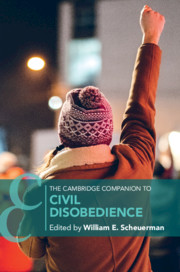Book contents
- The Cambridge Companion to Civil Disobedience
- Cambridge Companions to Philosophy
- The Cambridge Companion to Civil Disobedience
- Copyright page
- Contents
- Contributors
- Introduction: Why, Once Again, Civil Disobedience?
- Part I Plural Voices, Rival Frameworks
- Part II Different Elements, Competing Interpretations
- Part III Changing Circumstances, Political Consequences
- 12 Global Citizenship, Global Civil Disobedience, and Political Vices
- 13 Civil Disobedience by States?
- 14 Coding Resistance: Digital Strategies of Civil Disobedience
- 15 Whistleblowing as Civil Disobedience
- 16 Consequences of Civil Disobedience
- Index
- Cambridge Companions to Philosophy
14 - Coding Resistance: Digital Strategies of Civil Disobedience
from Part III - Changing Circumstances, Political Consequences
Published online by Cambridge University Press: 24 June 2021
- The Cambridge Companion to Civil Disobedience
- Cambridge Companions to Philosophy
- The Cambridge Companion to Civil Disobedience
- Copyright page
- Contents
- Contributors
- Introduction: Why, Once Again, Civil Disobedience?
- Part I Plural Voices, Rival Frameworks
- Part II Different Elements, Competing Interpretations
- Part III Changing Circumstances, Political Consequences
- 12 Global Citizenship, Global Civil Disobedience, and Political Vices
- 13 Civil Disobedience by States?
- 14 Coding Resistance: Digital Strategies of Civil Disobedience
- 15 Whistleblowing as Civil Disobedience
- 16 Consequences of Civil Disobedience
- Index
- Cambridge Companions to Philosophy
Summary
The transformative effects of digitalization have not left civil disobedience untouched. On the contrary, civil disobedience today is increasingly interlinked with digital technologies, though individual examples exhibit different degrees of dependency on technology and are constituted by varying types of interactions between humans and machines. Digital actions have become integrated into daily life; it may soon seem unnecessary or even counterintuitive to label them digital at all. For some members of society, the digital becomes an increasingly empty signifier, as human activity in general becomes dependent on technology in unconscious and invisible ways. Despite the ubiquity of computing and human-machine entanglement, political and public discourses linger uneasily between embracing and resisting digitalization. The digital still functions as a placeholder that signifies a less familiar, valid, or even less real type of action.
Nevertheless, the Internet has changed “almost every aspect of politics, and its presence in politics is ubiquitous.”1 Digital forms of activism and protest have been at the forefront of these changes and have played a vital role in the digital rights movement as a whole.
- Type
- Chapter
- Information
- The Cambridge Companion to Civil Disobedience , pp. 359 - 383Publisher: Cambridge University PressPrint publication year: 2021



